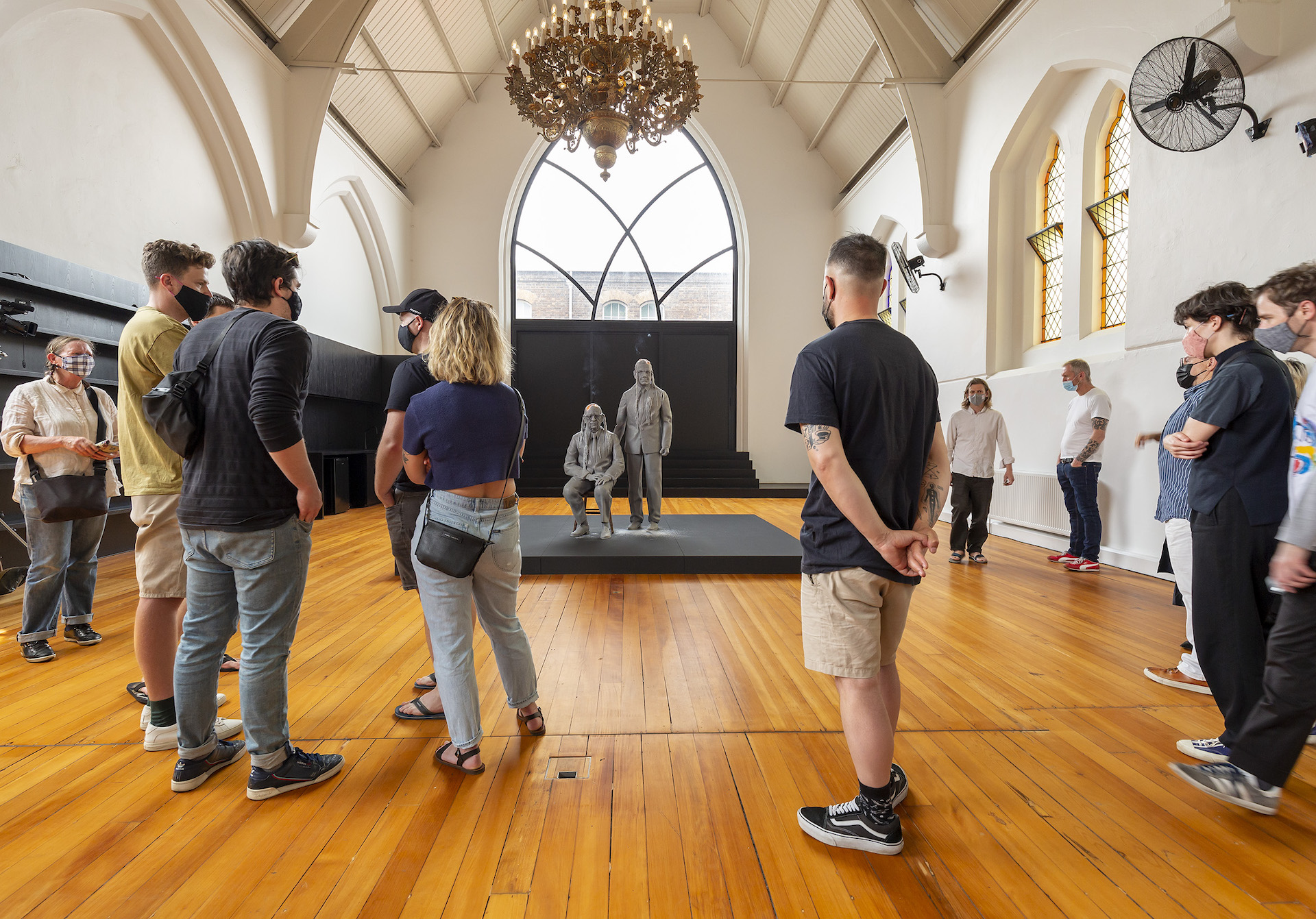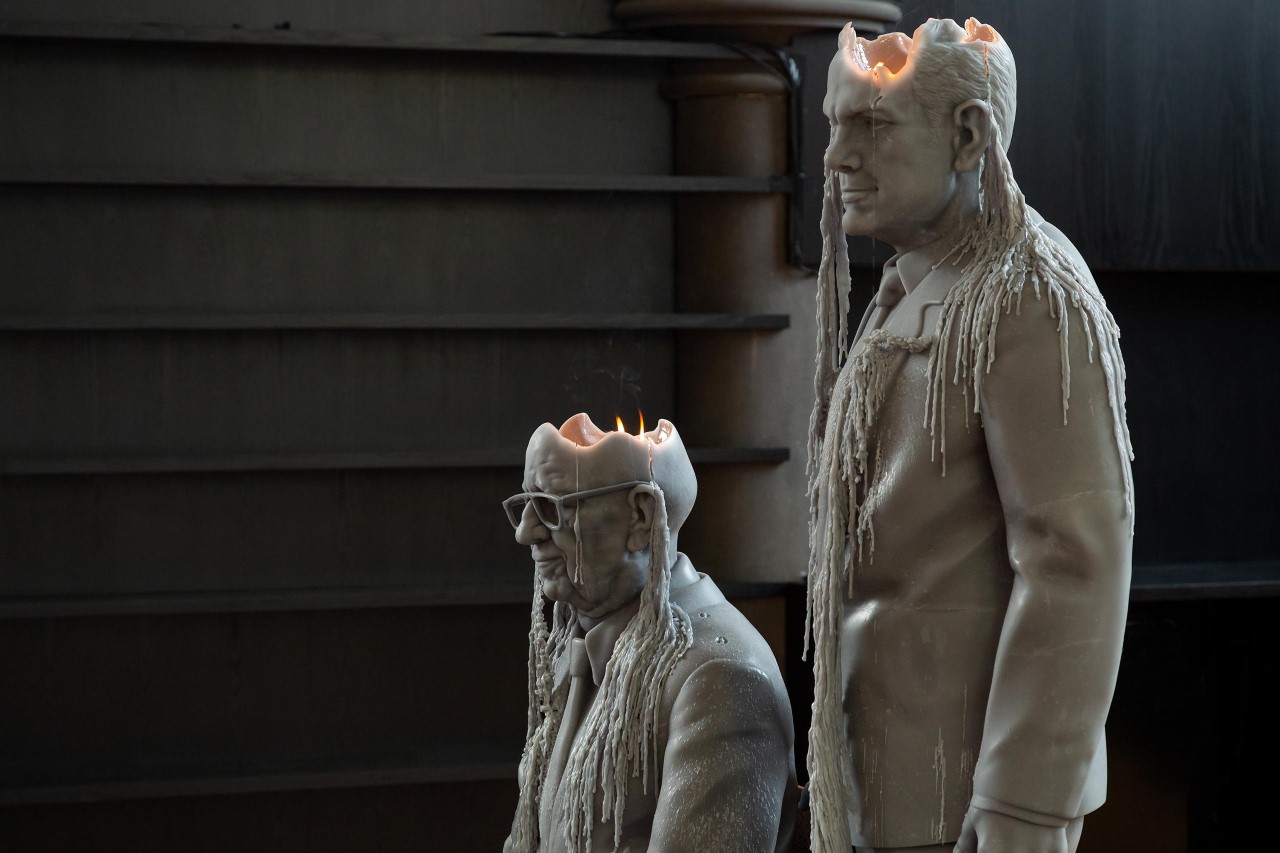Jeremy Deller: Father and Son
Hilary Thurlow
Surely one of the best works of the year: Artist #JeremyDeller @jeremydeller just finished Australian Center for Contemporary Art in Melbourne @acca_melbourne - a 24-hour ritual public burning - and purging from the collective metaphysical body - of Rupert and Lachlan Murdoch.
Jerry Saltz, Instagram
From midday to midnight in the (once Anglican, now deconsecrated) St Saviour’s Church of Exiles in Melbourne’s Collingwood, Australia’s most bemoaned media baron and his eldest son were set alight. Staged by the Australian Centre for Contemporary Art (ACCA), UK-based artist Jeremy Deller’s Father and Son returned Melbourne-born Rupert Murdoch to his birthplace along with his son, Lachlan. Instead of flesh and bone, the media mogul and his heir-apparent appeared as life-size unscented grey candles. The identities of the wax figures were more obvious to some than others—granted they did look a bit like the artist-duo Gilbert and George—with no material released by ACCA or Deller identifying the melting bodies.

Prior to taking part in the vigil, my social media was flooded with applause for Deller and images of Rupert and Lachlan’s melting faces. I felt a surprising sense of déjà vu and was immediately reminded of National Gallery of Australia Director, Nick Mitzevich, lighting a $1 million-dollar Urs Fischer candle sculpture of Italian curator, Francesco Bonami. Disappointingly, ACCA’s director Max Delany did not set fire to Rupert and Lachlan Murdoch, rather an expert in candle-making had the envious task of setting the media mogul and his heir-apparent alight.
Installed under an ornate chandelier and centred toward the back of the defunct church, Father and Son sat atop a short black plinth. Both men are dressed in suits and ties, with Rupert atop a wooden chair appearing posed, his expression indifferent and his hands gently resting against his left leg. Clad in formal business wear, the patriarch’s lapels are peaked and his tie is straight. Lachlan stands behind him, quite literally in his shadow. As the installation slowly deteriorated, threads of wax comically formed from Lachlan and Rupert’s heads, falling somewhere between a strange skin condition and a stalactite formation. The pair’s configuration could be that of any corporate photo used for a company’s PR; we could speculate the Father and Son even acts as prophecy, one that reveals whose shoulders the future of News Corp has been placed upon.
Lachlan, the CEO of Fox Corporation, has a placid, upturned mouth that forms not quite a smile or a smirk but somewhere in-between. The finer details in his attire are more casual than that of his father’s: he wears boots—bearing a striking resemblance to every Australian corporate patriarch’s favoured casual shoe, the RM Williams—while his father’s feet are fitted with a more formal oxford. The length of Lachlan suit jacket sleeve falls below his wrists and his suit pants pool at his feet. In Deller’s family portrait, the eldest Murdoch child ushers in a new breed of corporate shill. He’s casual and cool. He thinks he’s the zeitgeist and might be heard screaming “fuck the patriarchy” at his female employees, all the while perpetuating the misogynistic behaviour his father undoubtedly acted out before him.
Visitors moved back and forth between the former church and other sites in Collingwood, hoping to catch the moment the men’s faces slid to the floor. When Lachlan’s face finally fell the congregation audibly cheered. A portion of Rupert’s face surrendered to gravity a while later to similar ovation. When faceless, the headless bodies gained anonymity. Unless you closely examined the wax remnants resting at Rupert and Lachlan’s feet, the pair could have been any men in office garb. Perhaps the best analogy to draw is between Murdoch’s kingdom and the faceless man. Although never elected to office, Rupert and his staff (children included) have so cleverly played the role of nascent and unknown politicians spurring factional divides. Politicians (think David Cameron) have ingratiated themselves with Rupert and his cronies, fearful of the undeniable strong hold he has over the government’s fourth arm: the media.

Deller’s patronising gesture of repatriating an exiled Rupert and his son as melting bodies to Collingwood is not necessarily where the strength of the work lies. Instead, the grace of Father and Son lies with Deller reminding us of Murdoch’s transnational power and global reach. Deller has lived through Rupert’s heavy-handed meddling in UK politics and tabloids. Under the mogul’s watchful eye, a string of irreversible changes has taken place: Brexit; phone hacking; the News of the World scandals; and turning against Labor incumbent Tony Blair on a dime to kowtow to Tory favourite David Cameron. Then in the United States, Rupert and Lachlan pushed Donald Trump to victory with “alternative facts” that saw divisive politics sweep the nation, turning blue states red and red states blue. The Murdoch’s also had a short-lived stint in China and Hong Kong, but Rupert’s unique brand of media influence proved too much of a threat to government power. Here in Australia, our revolving door of Prime Ministers and inaction on climate change are par for the course in Rupert’s gambit.
Giving no hints as to the content of the work, ACCA’s promotional material surrounding the installation was a “public vigil, as an invitation for the public to bear witness to, and reflect upon, questions of power, influence and generational change, represented through the figurative depiction of a father and son, cast in the soft light of remembrance.” ACCA also shared a Biblical passage that apparently underpinned Deller’s wax sculpture: “Truly, truly, I say to you, the Son can do nothing of his own accord, but only what he sees the Father doing. For whatever the Father does, that the Son does likewise” — John 5:19. The passage is a stark reminder of how intergenerational habits die hard and how bad dads have existed for quite a while, with perhaps God among them.
The succession plan for 90-year-old Rupert’s empire has long been a topic of conversation in every tabloid bar those owned by News Corp. Rupert’s three children from his second marriage have all at times been pegged as the future leader of the transnational conglomerate. But as Rupert’s second daughter, Elisabeth, stepped back from the family firm so too has his second son James, leaving only Lachlan as a key player to take over the Murdoch empire. Intrigue as to who will inherent the family’s empire even informs the plot of the popular HBO television show Succession, bolstering the family’s star power and beckoning an extra layer of folklore around them. Rupert’s marriage to high-profile 1970s supermodel Jerry Hall has also reinforced the family’s celebrity. Deller’s sculpture almost pays homage to the family’s fame, sharing a likeness to those wax celebrities found at Madame Tussauds.

What many forget is that Rupert was a product of nepotism and born into a media dynasty. His father Keith Murdoch had already established a conservative-led series of newspapers across Australia. But Rupert, like Icarus, wanted to fly closer to The Sun than his father before him and test his wax-laden wings. Just as religious missionaries spread the word of God throughout the world, the mogul transformed a few Australian papers into a transnational empire of biblical proportions: reaping all the rewards of a hyper accelerated globalism spurred by endless flows of global investment, instantaneous communication networks and a 24-hour news cycle. Even those outside of Melbourne could bear witness to Deller’s vigil-cum-effigy and tune in on ACCA’s website where a livestream beamed into every corner of the world. A sign of the global reach of Rupert’s empire and a nod to contemporary art’s globalism.
Murdoch’s Roman Catholicism is something of an open secret. In 1998, Pope John Paul II bestowed Rupert with an elusive papal knighthood, an honour given only to people of “unblemished character”. The site was presumably chosen for its connections to religion. Yet in a deconsecrated church there is no God. No pews and only a few symbols of faith remain, the true telling of the site’s past made most obvious by way of its cavernous architecture. It feels immoral to draw parallels between God and Rupert but here we are: he’s lived a life of mythology, rumour and instruction. Known for a notoriously megalomaniac leadership style, overseeing every aspect of his empire, and infamously acting on instinct alone Rupert has constructed a Kingdom where he is the God.

The heavy emphasis on the Bible seems like an arbitrary allegory to draw for a seemingly secular crowd, but it’s one that would take the sting out of any malicious litigation by camp Murdoch—notorious for threatening defamation cases and aggressively campaigning against critics via all media channels at the company’s disposal, even threatening action against the Australia’s national broadcaster over a recent Four Corners report. Rumour has it the work was originally slated for Rising Festival (an unfortunate victim of Melbourne’s countless COVID outbreaks) but was pulled due to fears of facing News Corp’s vitriol. Deller’s wax figures had lain in wait for months, even surviving Melbourne’s 5.9 magnitude earthquake—by the grace of God.

On a final note, and in reference to my epigraph, I think it would be remiss not to give a quick mention to the torrent of art criticism that has followed Deller’s temporary installation. Unlike the banal coverage these kinds of presentations tend to garner in mainstream press, Father and Son launched a softly spoken war of words; not about the artwork but art criticism itself. The day after the work premiered it received run-of-the-mill coverage in Fairfax’s The Age and The Guardian. The Age’s critic saw only God and no Murdoch, while The Guardian’s saw only Murdoch and no God. Four days following the antithetical reviews The Guardian published “Melbourne art critic reviews melting Murdochs without noticing Rupert or Lachlan” leading to the critic from The Age publishing a retort titled “I missed the point of a major new artwork – but does it matter?” After a few hours, Rupert and Lachlan became faceless and generic men. Father and Son even caught the attention of Pulitzer Prize winning critic Jerry Saltz, who shared low resolution images of the work on Instagram—his favourite publishing platform for art criticism. The comments under Saltz’s post echoed his sentiments and were glowing with praise for Deller’s vanitas. As we constantly lament the death and dearth of art criticism in mainstream press, Father and Son albeit unwittingly serves as a reminder of how easy it is to get it wrong and the necessity of getting it right.
With the firm’s politics pivoting without warning to garner public favour, i.e. The Australian et al turning their backs on climate denial and wielding their power to get Scott Morrison to COP26, it feels unlikely Murdoch’s empire will burn to the ground anytime soon. But one can dream, as Deller here has encouraged us to do. I’m sure Kevin Rudd and Malcom Turnbull will be hoping Deller’s effigy become reality too.
Hilary Thurlow is a Master’s candidate in Art History and Theory at Monash University. Her research centres on the work of Cuban artist, Tania Bruguera.


